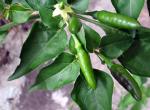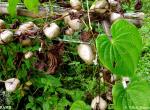ganglionar inflammation
Capsicum annuum(In territories with significant traditional TRAMIL use)
Significant uses found by the TRAMIL surveys leaf, heated and greased in fat, applied locally1-2 |
Recommandations
Preparation and posology References |
According to published and other information: The use for boils and ganglionary inflammation is classified as REC, based on the significant traditional use (WHO)4 documented in the TRAMIL surveys. Do not apply leaf for more than three minutes after local erythema (reddening) appears (normal reaction). For topical application, strict hygiene measures should be observed in order to avoid contamination or additional infection. Self-medication should not be used in cases of boils or carbuncles on the face or neck where there is a risk of septicemia. Adverse interaction with barbituric medicines has been documented, therefore ingestion of any plant part should be avoided by people taking these or other medicines metabolized in the liver. The fruit powder may cause reactions of skin hypersensitivity. |
The fruit ofCapsicum annuum is widely used for human consumption. TRAMIL research28 For boils and ganglionary inflammation: Wash injury with boiled water and soap, apply 2-4 grams of leaf to affected area. Note: The popular practice of greasing in fat probably facilitates extraction of the active principle with the rubefacient effect -i.e. capsaicin-, but it carries the risk of overadded infection. |
1 GERMOSEN-ROBINEAU L, GERONIMO M, AMPARO C, 1984 Encuesta TRAMIL. enda-caribe, Santo Domingo, Rep. Dominicana. 2 WENIGER B, 1987-88 Encuesta TRAMIL. enda-caribe, Santo Domingo, Rep. Dominicana. 3 BALLAND V, GLASGOW A, SPRINGER F, GAYMES G, 2004 TRAMIL survey. enda-caribbean, IICA, UAG & U.PARIS XI, Saint Vincent. 4 OMS/WHO, 1991 Pautas para la evaluación de medicamentos herbarios WHO/TRM/91.4 (original inglés). Programa de Medicina Tradicional, OMS, Ginebra, Suiza. 5 GUTSU EV, KINTYA PK, LAZURIIEVSKII GV, Balashova nn, 1984 Steroid alkaloids and glycosides of Capsicum annuum L. Rast Resur 20(1):127-130. 6 POLITIS J, 1948 Distribution of chlorogenic acid in solanaceae and in the organs of these plants. Compt Rend 226:692-693. 7 TOMAS F, FERRERES F, 1980 Flavonoids from the leaves of Capsicum annuum (Solanaceae). I. Major components. Afinidad 37:517-518. 8 COOPER TH, GUZINSKI JA, FISHER C, 1991 Improved high-performance liquid chromatography method for the determination of major capsaicinoids in Capsicum oleoresins. J Agric Food Chem 39(12):2253-2256. 9 DUKE JA, ATCHLEY AA, 1986 Handbook of proximate analysis tables of higher plants.Boca Raton, USA: CRC Press. p35. 10 VLIETINCK AJ, VAN HOOF L, TOTTE J, LASURE A, VANDERBERGHE D, RWANGABO PC, MVUKIYUMWAMIJ, 1995 Screening of hundred Rwandese medicinal plants for antimicrobial and antiviral properties. J Ethnopharmacol 46(1):31-47. 11 CACERES A, LOPEZ BR, GIRON MA, LOGEMANN H, 1991 Plants used in Guatemala for the treatment of dermatophytic infections. 1. Screening for antimycotic activity of 44 plant extracts. J Ethnopharmacol 31(3):263-276. 12 FENG PC, HAYNES LJ, MAGNUS KE, PLIMMER JR, 1964 Further pharmacological screening of some West Indian medicinal plants. J Pharm Pharmacol Suppl16:115. 13 ABDOU IA, ABDOU-ZEID AA, EL-SHERBEENG MR, ABDOU-EL-EHEAT ZH, 1972 Antimicrobial activities of Allium sativum, Allium cepa, Raphanus sativus, Capsicum frutescens, Eruca sativa, Allium kurat on bacteria. Qual Plant Mater Veg22(1):29-35. 14 CICHEWICZ RH, THORPE PA, 1996 The antimicrobial properties of chili peppers (Capsicum species) and their uses in Mayan medicine. J Ethnopharmacol52(2):61-70. 15 CACERES A, ALVAREZ AV, OVANDO AE, SAMAYOA BE, 1991 Plants used in Guatemala for the treatment of respiratory diseases. 1. Sreening of 68 plants against gram-positive bacteria. J Ethnopharmacol 31:193-208. 16 SAMBAIAH K, SATYANARAYANA MN, 1980 Hypocholesterolemic effect of red pepper and capsaicin. Indian J Exp Biol18:898-899. 17 DUKE JA, 1992 Handbook of biologically active phytochemicals and their activities.Boca Raton, USA: CRC Press. 18 DUKE JA, 2000 Chemicals and their biological activities in: Capsicum annuum L. Dr. Duke’s Phytochemical and Ethnobotanical Databases.USDA-ARS-NGRL, Beltsville Agricultural Research Center, Beltsville, USA, Aug.10,2000. URL: http://www.ars-grin.gov/cgi-bin/duke/farmacy2.pl 19 DHAWAN BN, PATNAIK GK, RASTOGI RP, SINGH KK, TANDON JS, 1977 Screening of Indian plants for biological activity VI. Indian J Exp Biol 15:208-219. 20 ROCKWELL P, RAW J, 1979 A mutagenic screening of various herbs, spices and food additives. Nutr Cancer 1:10-15. 21 NAGABHUSHAN M, BHIDE SV, 1985 Mutagenicity of chili extract and capsaicin in short term test. Environ Mutagen 7:881-888. 22 HAN Y, SHIN K, WOO W, 1984 Effect of spices on hepatic microsomal enzyme function in mice. Arch Pharm South Korea Res7(1):53-56. 23 SANCHEZ-PALOMERA E, 1951 Concept of the mucous barrier and its significance. Gastroenterology18:269-286. 24 POUSSET JL, 1989 Plantes médicinales Africaines.Paris, France: ACCT. p38. 25 MEDING B, 1993 Skin symptoms among workers in a spice factory. Contact Derm 29(4):202-205. 26 GUZZO CA, LAZARUS GS, WERTH VP, 1996 Dermatological pharmacology. In: HARDMAN JG, GILMAN AG, LIMBIRD LE Eds. Goodman and Gilman’s the pharmacological basis of therapeutics. 9th ed. New York, USA: The McGraw-Hill Professional Publishing, International Edition. 27PEISKER V, ARANGUREN ML, MONTERO DE ESPINOSA E, MORAES J, LEAL MS, SANZ J, 1995 Vademécum Internacional. Madrid, España: Medicom S.A. 28CARBALLO A, 1995 Cálculo de concentración y dosis de las drogas vegetales TRAMIL: Mensuraciones farmacognósticas y aproximaciones técnico-clínicas. Laboratorio provincial de producción de medicamentos, Sancti Spiritus, Cuba. 29 MARTINEZ MJ, BETANCOURT J, LOPEZ M, MOREJON Z, FUENTES V, MORON F, 2005 Antimicrobial effect of fresh leaves and their juice of Capsicum annuum. Informe TRAMIL. Laboratorio Central de Farmacología, Facultad de Ciencias Médicas “Dr. Salvador Allende”, La Habana, Cuba. 30 MARTINEZ MJ, BETANCOURT J, LOPEZ M, MOREJON Z, FUENTES V, MORON F, 2005 Irritabilidad dérmica primaria de hoja fresca en aceite deCapsicum annuum. Informe TRAMIL. Laboratorio Central de Farmacología, Facultad de Ciencias Médicas “Dr. Salvador Allende”, La Habana, Cuba. 31 MARTINEZ MJ, BETANCOURT J, LOPEZ M, MOREJON Z, FUENTES V, MORON F, 2005 Clases Tóxicas Agudas Tópica de hoja fresca machacada deCapsicum annuum. Informe TRAMIL. Laboratorio Central de Farmacología, Facultad de Ciencias Médicas “Dr. Salvador Allende”, La Habana, Cuba. |
||
Dioscorea bulbifera(In territories with significant traditional TRAMIL use)
Significant uses found by the TRAMIL surveys grated tuber, applied locally1 |
Recommandations
Preparation and posology References |
According to published and other information: Use for abscess and ganglionar inflammation is classified as REC, based on the significant traditional use (OMS/WHO)4 documented in the TRAMIL surveys. For topical application, strict hygiene measures should be observed in order to avoid contamination or additional infection.
|
For abscess and ganglionar inflammation: There is no available information establishing a means of preparation and dosage other than that referred to by traditional use. |
1 WENIGER B, ROUZIER M, 1986 Enquête TRAMIL. Service Oecuménique d'Entraide SOE, Port au Prince, Haïti. 2 WHO, 1991 Guidelines for the assessment of herbal medicines. WHO/TRM/91.4. Programme on Traditional Medicines, WHO, Geneva, Switzerland. 3 IDA Y, KUBO S, FUJITA M, KOMORI T, KAWASAKI T, 1978 Furanoid diterpenes from plants of the Discoreaceae. V. Structure of diosbulbin D, E, F, G & H. Justus Liebigs Ann Chem. p818. 4 IDA Y, NODA W, KUBO S, KOMORI T, KAWASAKI T, 1978 Furanoid norditerpenes from Dioscorea plants. VII. Structures of diosbulbinosides D & F. Chem Pharm Bull 26:435. 5 MURRAY R, JORGE KHAN N, SHAHJAHAN M, QUAISUDDIN M, 1984 Diosbulbin D and 8-epidiosbulbin E acetate, norclerodane diterpenoids from Dioscorea bulbifera tubers. Phytochemistry 23(3):623-625. 6 KHAN N, NUR-E-KAMAL M, SHAHJAHAN M, HASAN C, 1986 Chemical investigation of tubers of Dioscorea bulbifera l. Variety sativa. Khaka Univ Stud Part B 34(1):111-113. 7 GUPTA D, SINGH J, 1989 Hydroxy-acetophenone derivatives from Dioscorea bulbifera. Phytochemistry 28(3):947-949. 8 IRELAND C, SCHWABE W, GOURSEY D, 1981 The occurrence of batatasins in the Dioscoreaceae. Phytochemistry 20:1569-1571. 9 RAGHUNADAN K, JOLLY C, 1987 Starch from Dioscorea bulbifera. Indian J Pharm Sci 49(6):233-236. 10 DUKE JA, ATCHLEY AA, 1986 Handbook of proximate analysis tables of higher plants. Boca Raton, USA: CRC Press. p64. 11 ABDEL-AZIZ A, BRAIN K, BASHIR A, 1990 Screening of Sudanese plants for molluscicidal activity and identification of leaves ofTacca leontopetaloides L. O. Ktze (Taccaceae), as a potential new exploitable resource. Phytother Res 4(2):62-65. 12 CHEN L, 1988 Treatment of 11 cases of malignant lymphoma. Zhejiang J Trad Chin Med 23(8):365-366. 13 SATO A, 1989 Studies on anti-tumor activity of crude drugs. I. The effects of aqueous extracts of some crude drugs in short term screening test. Yakugaku Zasshi 109(6):407-423. 14 YAN Z, 1989 Adverse reactions to Chinese drugs, 384 cases. Chin Pharmaceut J 24(3):166-169. |

